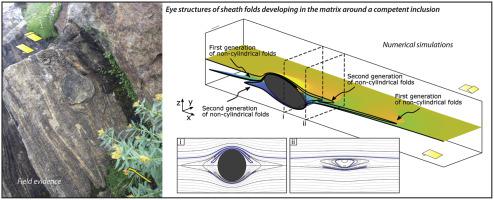当前位置:
X-MOL 学术
›
J. Struct. Geol.
›
论文详情
Our official English website, www.x-mol.net, welcomes your
feedback! (Note: you will need to create a separate account there.)
Sheath fold development around deformable inclusions: integration of field-analysis (Cima Lunga unit, Central Alps) and 3D numerical models
Journal of Structural Geology ( IF 2.6 ) Pub Date : 2021-03-01 , DOI: 10.1016/j.jsg.2020.104255 Matteo Maino , Marta Adamuszek , Filippo L. Schenker , Silvio Seno , Marcin Dabrowski
Journal of Structural Geology ( IF 2.6 ) Pub Date : 2021-03-01 , DOI: 10.1016/j.jsg.2020.104255 Matteo Maino , Marta Adamuszek , Filippo L. Schenker , Silvio Seno , Marcin Dabrowski

|
Abstract We investigated complex tectonic structures within a km-scale shear zone (Cima Lunga unit), which is traditionally interpreted as generated by multiple, distinct deformation phases, despite showing unique schistosity and lineation. Based on structural analyses we discovered sheath folds developed in relatively weak gneissic/schistose rocks, enveloping inclusions of stronger ultramafics. The internal layering of inclusions experienced superimposed folding, boudinage and folding, attesting to layer-parallel shortening followed by stretching and further again shortening. Using 3D numerical modelling, we explored the structure evolution within and around deformable viscous inclusions under far-field simple shear. The numerical results showed that the internal deformation of ellipsoidal inclusions and the fold development around the inclusions are both dependent on the viscosity ratio, shear strain and the inclusion aspect ratio. The Cima Lunga structural patterns were reproduced for finite strains exceeding 7.5 and viscosity ratio between 2.8 and 9. Inclusions are characterized by persistent rotation of the internal layering, resulting in super-simple shear regime, with kinematic vorticity number >1. An important corollary is that ultramafics and host rocks experienced coupled deformation since the prograde metamorphic evolution. Finally, we emphasise that progressive deformation in shear zones may offer sufficient explanation for complex structural patterns, without invoking unjustified polyphase deformation.
中文翻译:

可变形夹杂物周围的鞘褶发育:场分析(Cima Lunga 单元,中央阿尔卑斯山)和 3D 数值模型的整合
摘要 我们研究了公里尺度剪切带(Cima Lunga 单元)内的复杂构造结构,传统上将其解释为由多个不同的变形阶段产生,尽管显示出独特的片理和线理。基于结构分析,我们发现在相对较弱的片麻岩/片岩岩中发育出鞘褶皱,包裹着更强的超基性岩包裹体。夹杂物的内部分层经历了叠加折叠、布丁和折叠,证明层平行缩短,然后拉伸,再进一步缩短。使用 3D 数值建模,我们探索了远场简单剪切下可变形粘性夹杂物内部和周围的结构演变。数值结果表明,椭圆形包裹体的内部变形和包裹体周围褶皱的发展均取决于粘度比、剪切应变和包裹体纵横比。Cima Lunga 结构模式在超过 7.5 的有限应变和 2.8 和 9 之间的粘度比下重现。夹杂物的特征是内部分层的持续旋转,导致超简单的剪切状态,运动涡度数 >1。一个重要的推论是,自顺行变质演化以来,超基性岩和主岩经历了耦合变形。最后,我们强调剪切带中的渐进变形可以为复杂的结构模式提供充分的解释,而不会引起不合理的多相变形。剪切应变和夹杂物纵横比。Cima Lunga 结构模式在超过 7.5 的有限应变和 2.8 和 9 之间的粘度比下重现。夹杂物的特征是内部分层的持续旋转,导致超简单的剪切状态,运动涡度数 >1。一个重要的推论是,自顺行变质演化以来,超基性岩和主岩经历了耦合变形。最后,我们强调剪切带中的渐进变形可以为复杂的结构模式提供充分的解释,而不会引起不合理的多相变形。剪切应变和夹杂物纵横比。Cima Lunga 结构模式在超过 7.5 的有限应变和 2.8 和 9 之间的粘度比下重现。夹杂物的特征是内部分层的持续旋转,导致超简单的剪切状态,运动涡度数 >1。一个重要的推论是,自顺行变质演化以来,超基性岩和主岩经历了耦合变形。最后,我们强调剪切带中的渐进变形可以为复杂的结构模式提供充分的解释,而不会引起不合理的多相变形。包裹体的特点是内部层状结构的持续旋转,导致超简单的剪切状态,运动涡度数 >1。一个重要的推论是,自顺行变质演化以来,超基性岩和主岩经历了耦合变形。最后,我们强调剪切带中的渐进变形可以为复杂的结构模式提供充分的解释,而不会引起不合理的多相变形。包裹体的特点是内部层状结构的持续旋转,导致超简单的剪切状态,运动涡度数 >1。一个重要的推论是,自顺行变质演化以来,超基性岩和主岩经历了耦合变形。最后,我们强调剪切带中的渐进变形可以为复杂的结构模式提供充分的解释,而不会引起不合理的多相变形。
更新日期:2021-03-01
中文翻译:

可变形夹杂物周围的鞘褶发育:场分析(Cima Lunga 单元,中央阿尔卑斯山)和 3D 数值模型的整合
摘要 我们研究了公里尺度剪切带(Cima Lunga 单元)内的复杂构造结构,传统上将其解释为由多个不同的变形阶段产生,尽管显示出独特的片理和线理。基于结构分析,我们发现在相对较弱的片麻岩/片岩岩中发育出鞘褶皱,包裹着更强的超基性岩包裹体。夹杂物的内部分层经历了叠加折叠、布丁和折叠,证明层平行缩短,然后拉伸,再进一步缩短。使用 3D 数值建模,我们探索了远场简单剪切下可变形粘性夹杂物内部和周围的结构演变。数值结果表明,椭圆形包裹体的内部变形和包裹体周围褶皱的发展均取决于粘度比、剪切应变和包裹体纵横比。Cima Lunga 结构模式在超过 7.5 的有限应变和 2.8 和 9 之间的粘度比下重现。夹杂物的特征是内部分层的持续旋转,导致超简单的剪切状态,运动涡度数 >1。一个重要的推论是,自顺行变质演化以来,超基性岩和主岩经历了耦合变形。最后,我们强调剪切带中的渐进变形可以为复杂的结构模式提供充分的解释,而不会引起不合理的多相变形。剪切应变和夹杂物纵横比。Cima Lunga 结构模式在超过 7.5 的有限应变和 2.8 和 9 之间的粘度比下重现。夹杂物的特征是内部分层的持续旋转,导致超简单的剪切状态,运动涡度数 >1。一个重要的推论是,自顺行变质演化以来,超基性岩和主岩经历了耦合变形。最后,我们强调剪切带中的渐进变形可以为复杂的结构模式提供充分的解释,而不会引起不合理的多相变形。剪切应变和夹杂物纵横比。Cima Lunga 结构模式在超过 7.5 的有限应变和 2.8 和 9 之间的粘度比下重现。夹杂物的特征是内部分层的持续旋转,导致超简单的剪切状态,运动涡度数 >1。一个重要的推论是,自顺行变质演化以来,超基性岩和主岩经历了耦合变形。最后,我们强调剪切带中的渐进变形可以为复杂的结构模式提供充分的解释,而不会引起不合理的多相变形。包裹体的特点是内部层状结构的持续旋转,导致超简单的剪切状态,运动涡度数 >1。一个重要的推论是,自顺行变质演化以来,超基性岩和主岩经历了耦合变形。最后,我们强调剪切带中的渐进变形可以为复杂的结构模式提供充分的解释,而不会引起不合理的多相变形。包裹体的特点是内部层状结构的持续旋转,导致超简单的剪切状态,运动涡度数 >1。一个重要的推论是,自顺行变质演化以来,超基性岩和主岩经历了耦合变形。最后,我们强调剪切带中的渐进变形可以为复杂的结构模式提供充分的解释,而不会引起不合理的多相变形。











































 京公网安备 11010802027423号
京公网安备 11010802027423号